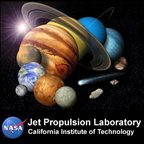
Podcast for audio and video - NASA's Jet Propulsion Laboratory
Summary: Video and audio podcasts from NASA's Jet Propulsion Laboratory feature the latest news on space and science findings from JPL and NASA. Topics include discoveries made by spacecraft studying planets in our solar system, including Mars, Saturn and our home planet, Earth. Missions also study stars and galaxies in our universe. Other topics cover tips for amateur astronomers and updates from the Mars Rover and Cassini missions.
- Visit Website
- RSS
- Artist: Video and audio podcasts
- Copyright: no copyright
Podcasts:
Black and white and color animations made with new data from NASA's Dawn spacecraft highlight the topography of Occator crater on Ceres.
A robot concept called Hedgehog would explore the microgravity environment of comets and asteroids by hopping and rolling around on them.
A total eclipse of the Harvest moon, plus planets and the late summer milky way.
Oceanographer Josh Willis from NASA's Jet Propulsion Laboratory narrates this video about the causes of sea level rise and how sea level has changed over the last two decades as observed by the Jason series of satellite missions.
The first 50 years of successful NASA missions to the Red Planet.
How geckos inspired a new NASA technology that makes things stick to each other in space.
How geckos inspired a new NASA technology that makes things stick to each other in space.
Jupiter's moon Europa may have an ocean more than twice the size of Earth's oceans combined. Why do scientists think so? Find out in 60 seconds.
This video shows a series of animations of dwarf planet Ceres, generated from data from NASA's Dawn spacecraft.
After three action-packed years on Mars, the Curiosity rover is ready to take on higher slopes of Mount Sharp.
What's Up for August. The best Perseid meteor shower in years! And view all the current and former planets this month!
Movie made from radar images of asteroid 1999 JD6, obtained on July 25, 2015. The asteroid is approximately 1.2 miles (2 kilometers) on its long axis.
This animation shows a color-coded map from NASA's Dawn mission revealing the highs and lows of topography on the surface of dwarf planet Ceres.
Scientists using two giant, Earth-based radio telescopes bounced radar signals off passing asteroid 2011 UW158 to create images for this animation showing the rocky body's fast rotation. The passing asteroid made its closest approach to Earth on July 19, 2015 at 7:37 a.m. PST (4:37 a.m. EST) at a distance of about 1.5 million miles (2.4 million kilometers, or 6 times the distance from Earth to the moon). The close proximity during the pass made 2011 UW158 one of the best asteroid flybys of 2015 for imaging from Earth using radar.
Mariner 4 was the first spacecraft to fly by Mars and send home close-up images. Find out how the mission changed the way we explore the Red Planet.